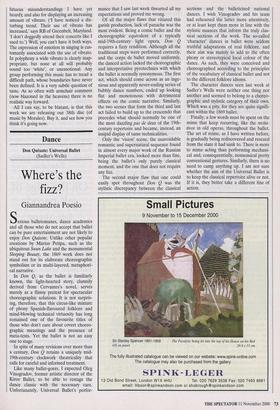Dance
Where's the fizz?
Giannandrea Poesio
Serious balletomanes, dance academics and all those who do not accept that ballet can be pure entertainment are not likely to enjoy Don Quixote. Unlike other popular creations by Marius Petipa, such as the ubiquitous Swan Lake and the monumental Sleeping Beauty, the 1869 work does not stand out for its elaborate choreographic symbolism or its multi-layered, metaphori- cal narrative.
In Don Q, as the ballet is familiarly known, the light-hearted story, clumsily derived from Cervantes's novel, serves merely as a flimsy pretext for spectacular choreographic solutions. It is not surpris- ing, therefore, that this circus-like mixture of phony Spanish-flavoured folklore and mind-blowing technical virtuosity has long remained one of the favourite titles of those who don't care about covert choreo- graphic meanings and the presence of meta-texts. Yet the ballet is not an easy one to stage.
In spite of many revisions over more than a century, Don Q retains a uniquely mid- 19th-century clockwork theatricality that calls for careful and informed treatment.
Like many ballet-goers, I expected Oleg Vinogradov, former artistic director of the Kirov Ballet, to be able to restage the dance classic with the necessary care. Unfortunately, Universal Ballet's perfor- mance that I saw last week thwarted all my expectations and proved me wrong.
Of all the major flaws that vitiated this garish production, lack of panache was the most evident. Being a comic ballet and the choreographic equivalent of a typically mid-19th-century light opera, Don Q requires a fizzy rendition. Although all the traditional steps were performed correctly, and the corps de ballet moved uniformly, the danced action lacked the choreographic and interpretative pyrotechnics with which the ballet is normally synonymous. The first act, which should come across as an inge- nious and apparently never-ending series of bubbly dance numbers, ended up looking flat and monotonous with detrimental effects on the comic narrative. Similarly, the two scenes that form the third and last act failed to build up to the crescendo that precedes what should normally be one of the most dazzling pas de deux of the 19th- century repertoire and became, instead, an insipid display of tame technicalities.
Only the 'vision' scene, the unavoidable romantic and supernatural sequence found in almost every major work of the Russian Imperial ballet era, looked more than fine, being the ballet's only purely classical moment, and the one that does not require any fizz.
The second major flaw that one could easily spot throughout Don Q was the stylistic discrepancy between the classical sections and the balleticised national dances. I wish Vinogradov and his team had rehearsed the latter more attentively, or at least kept them more in line with the stylistic nuances that inform the truly clas- sical sections of the work. The so-called `character' dances in ballet were seldom truthful adaptations of real folklore, and their aim was mainly to add to the often phony or stereotypical local colour of the dance. As such, they were conceived and choreographed according to the principles of the vocabulary of classical ballet and not to the different folklore idioms.
The character dances seen last week at Sadler's Wells were neither one thing nor another and seemed to belong to a choreo- graphic and stylistic category of their own. Which was a pity, for they are quite signifi- cant within the 1869 ballet.
Finally, a few words must be spent on the mime that keep recurring, like the recita- tivos in old operas, throughout the ballet. The art of mime, as I have written before, is gradually being rediscovered and rescued from the state it had sunk to. There is more to mime acting than performing mechani- cal and, consequentially, nonsensical pretty conventional gestures. Similarly, there is no need to camp anything up. I am not sure whether the aim of the Universal Ballet is to keep the classical repertoire alive or not. If it is, they better take a different line of action.


























































































 Previous page
Previous page